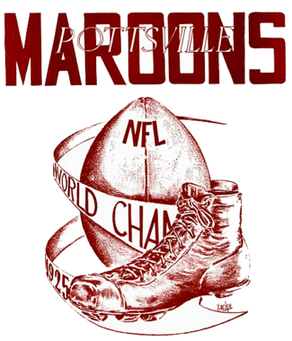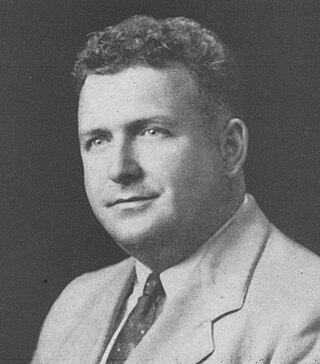Related Research Articles

The Pottsville Maroons were an American football team based in Pottsville, Pennsylvania, in the northeastern part of the state. Founded in 1920, they played in the National Football League (NFL) from 1925 to 1928. In 1929 they relocated to Boston, where they played one season as the Boston Bulldogs.
The Milwaukee Badgers were a professional American football team, based in Milwaukee, Wisconsin, that played in the National Football League from 1922 to 1926. The team played its home games at Athletic Park, later known as Borchert Field, on Milwaukee's north side. The team was notable for having many African-American players for the time.

Wilbur Francis "Pete" Henry was an American football player, coach, and athletic administrator. He was a charter inductee into both the College Football Hall of Fame in 1951 and the Pro Football Hall of Fame in 1963.

The 1925 National Football League (NFL) Championship, claimed by the Chicago Cardinals, has long been the subject of controversy, centering on the suspension of the Pottsville Maroons by NFL commissioner Joseph Carr, which prevented them from taking the title. The Maroons were one of the dominant teams of the 1925 season, and after defeating the Chicago Cardinals 21–7 on December 6, they came away with the best record in the league. However, Carr suspended and removed the team from the NFL after they played an unauthorized exhibition game in Philadelphia, on the grounds that they had violated the territorial rights of the Frankford Yellow Jackets. Chicago played and won two more games against weak NFL opponents, but were sanctioned because Cardinals player Art Folz hired four Chicago high school football players to play for the Milwaukee Badgers under assumed names to ensure a Cardinals victory.
Stanley Bingham Cofall was an American football player and coach.

Richard Harvie Rauch was an American football player and coach. Rauch attended Pennsylvania State University. He was a player-coach for the Boston Bulldogs, New York Yankees and the Maroons over the course of his five-year career. Rauch made his professional debut in the National Football League (NFL) in 1925 with the Pottsville Maroons. He was also the first NFL coach to institute daily practices.
The Coaldale Big Green was an early professional football team based in Coaldale, Pennsylvania. The club played as an independent until joining the Anthracite League in 1924. After leaving the league in 1924, the team spent its 1925 season as an independent, then joined the short-lived Eastern League of Professional Football in 1926. While the most well known Anthracite League team is the Pottsville Maroons, which jumped to the National Football League in 1925 and immediately established itself as a championship contender, the most consistently successful club in the coal region was the Big Green. Coaldale won the coal region's Curran Cup in 1921, 1922 and 1923.
The Eastern League of Professional Football was an american football minor league formed in 1926 by independent clubs from Pennsylvania and New Jersey. The Eastern League was a regional minor league that never intended to challenge either the National Football League or even Red Grange's new American Football League's, dominance over the sport.
The Gilberton Catamounts, sometimes called the Gilberton Cadamounts and the Gilberton Duck Streeters, were a 1920s-era professional football team based in Gilberton, Pennsylvania. However, the team played many of its home games in nearby Mahanoy City because Gilberton's home field, Stoddard Field, was usually flooded. The borough got its "Ducktown" nickname mainly because of persistent flooding.

Larner Somers Gardner Conover was a professional American football player who played during the early years of the National Football League (NFL). After attending high school in Atlantic City, New Jersey, Conover attended Penn State University, where he served as the team's captain in 1917. Conover was the head basketball and baseball coach and an assistant football coach at Clemson for the 1920–21 seasons.
Carl Linnwood Beck was a professional football player from Harrisburg, Pennsylvania. After attending high school, Beck attended the West Virginia University, Bucknell University and Lafayette College. He made his professional debut in the National Football League (NFL) in 1921 with the Buffalo All-Americans. He played for the All-Americans for 1 year, before leaving the NFL. He later returned to the NFL in 1925 as a star with both the Pottsville Maroons and the Frankford Yellow Jackets. To date, he is considered by sports writers to be one of the greatest running backs ever developed in Pennsylvania. When not playing football, Beck worked as a police officer for the Harrisburg Bureau of Police.
The Bethlehem Bears were an early professional football team from Bethlehem, Pennsylvania. The team was initiated and formed by Michael "Gyp" Downey who served as player-coach and the team's manager. The Bears competed in the Eastern League of Professional Football in 1926.
Louie Lehman Smyth was a professional football player for the Canton Bulldogs from 1920 until 1923. Smyth won two NFL championships with the Bulldogs in 1922 and 1923 and another with the Yellow Jackets in 1926. He also played for the Hartford Blues, Rochester Jeffersons and the Providence Steamroller. Outside of the National Football League (NFL), he played for the Gilberton Cadamounts of the Anthracite League. During his year in Gilberton, Smyth doubled as a player with the Jeffersons. In 1923 Smyth led the NFL in touchdowns, with 7.

Stanley Rankin Robb was an American football lineman and end who played one season in the National Football League (NFL) for the Canton Bulldogs. A native of Pittsburgh, Pennsylvania, he attended Peabody High School and Mercersburg Academy, after which he played college football for the Centre Praying Colonels (1920) and West Virginia Wesleyan Bobcats (1921). Robb began his professional football career in 1922, splitting the year between the Holmesburg Athletic Club and Philadelphia Quakers. He played the 1923 season with the Clifton Heights Orange & Black before joining the Pottsville Maroons for their Anthracite League championship year in 1924. Robb joined the Canton Bulldogs, coached by his brother Harry, in 1926, playing what would be his only three games in the NFL while scoring one touchdown. He later returned to Clifton Heights to finish his career.

The Bethlehem Bulldogs was a professional American football team based in Bethlehem, Pennsylvania from 1946 to 1950. They played in the American Football League and were a minor league professional affiliate of the Philadelphia Eagles of the National Football League.
The Wilkes-Barre Barons were an Anthracite League American football team that, according to historical records, played in only one game in the league's only year of existence, 1924.
Guy Thomas "Zeke" Roberts was a professional American football player in the early National Football League (NFL) and the first American Football League (AFL). He played for three pro teams over the course of two years. In 1926 he played with the Canton Bulldogs in the NFL and the Cleveland Panthers in the AFL. He played the following season with the NFL's Pottsville Maroons. Prior to his professional career, Roberts played college football for the Iowa State Cyclones.
The 1924 Pottsville Maroons season was their 5th season in existence. The team played in the Anthracite League would go on to post a 12-1-1 record and claim the League Championship. The team would play in the National Football League the following year.
Joseph Cyril Marhefka was a professional American football player who played halfback for the Pottsville Maroons and the Philadelphia Quakers. A native of Phillipsburg, New Jersey, he was recruited to Lafayette College, where he played on their football team for four years. He then had a three-year professional football career in the Anthracite, National Football, and first American Football leagues. Afterwards he worked as an English and Latin teacher, remaining involved in football by officiating high school and college games. He died in June 2003 at the age of 101.
References
- Zagorski, Joe (1987). "Anthracite League" (PDF). PFRA Annual (8). Professional Football Researchers Association: 1–5.
- Gill, Bob (1989). "Other Minor League" (PDF). Coffin Corner. 11 (8). Professional Football Researchers Association: 1–5. Archived from the original (PDF) on 2010-11-27.
- Carroll, John M. (1999). Fritz Pollard. University of Illinois Press. ISBN 0-252-06799-1.